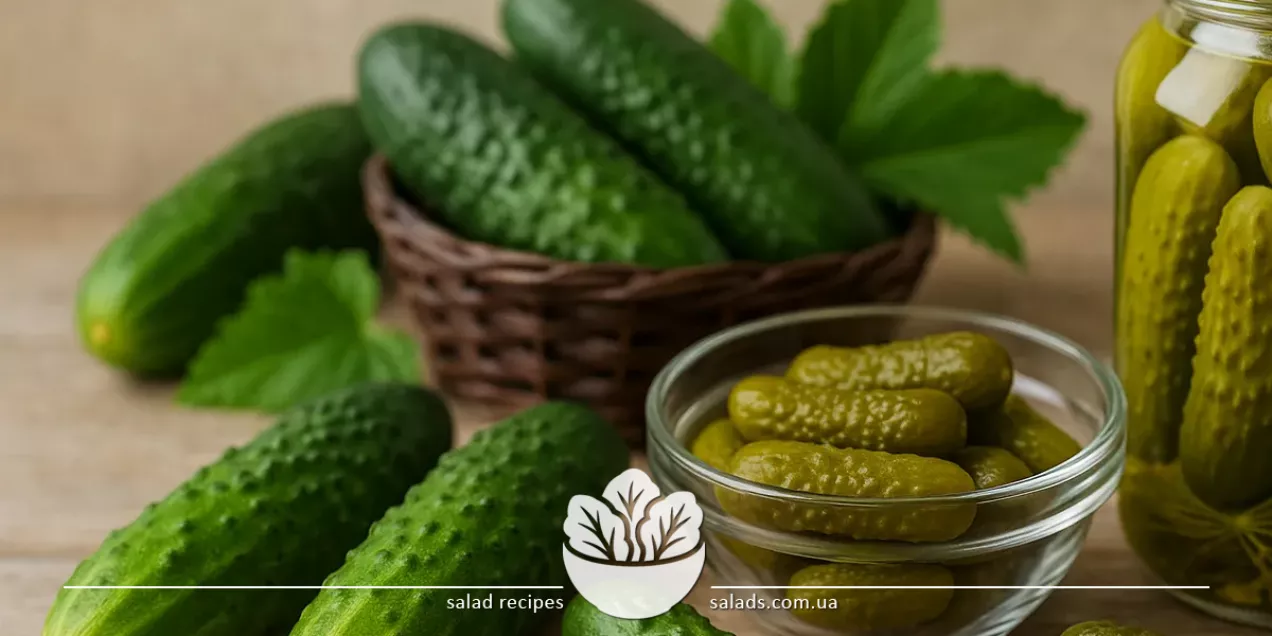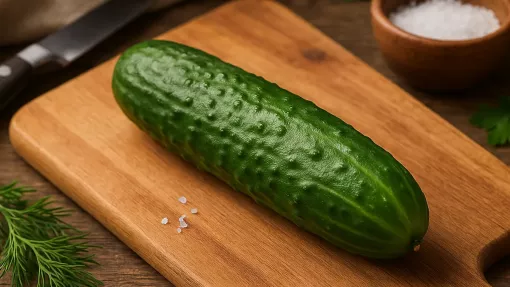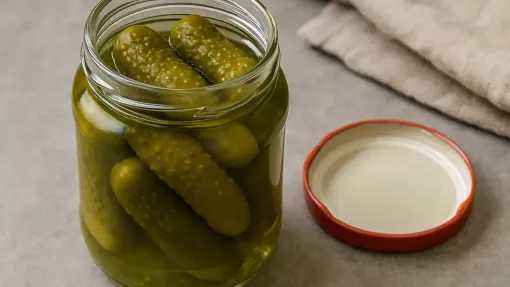Cucumbers

Cucumbers are juicy vegetables consumed both fresh and preserved. They are added to light salads, served with main dishes, stuffed, or preserved in jars. Their mild, neutral flavor blends well with other ingredients, and thanks to their high water content, cucumbers provide a refreshing effect in hot weather. In cuisines around the world, cucumbers can be served as stand-alone appetizers or as accompaniments to meat, fish, or dairy dishes. More about vegetable ingredients can be found in the vegetables category.
Different Types of Cucumbers
Varieties of Cucumbers and Their Uses
Cucumbers are divided into several main types: slicing (salad), pickling, and all-purpose. Slicing cucumbers have thin skin, soft flesh, and few seeds. They are primarily intended for fresh consumption without additional processing. These cucumbers are added to green salads, sandwiches, and cold soups. Thanks to their tender texture and refreshing flavor, they are also popular as simple appetizers. Pickling cucumbers have thicker skin, firm flesh, and small seeds. They retain their shape even after thermal or acidic treatment, making them ideal for pickling, marinating, and preserving. They are commonly prepared for winter as classic salted or sour pickles, often with spices, garlic, and herbs. These cucumbers are used as snacks, garnishes, or ingredients in salads like Olivier or layered herring salad.
There are also universal (all-purpose) varieties suitable for both fresh eating and preservation. They have medium density, balanced flavor, and retain their shape during storage. Supermarkets most often carry these hybrid types. In addition to size and structure, cucumbers differ in surface texture (smooth or bumpy), skin color, and fruit length. Some varieties have sweeter or more intense flesh, while others are watery and neutral. In different culinary traditions, cucumbers are used in various ways. In European cuisine, they are mainly a salad vegetable, in Eastern cuisine – a component of pickled appetizers, and in American cuisine – a key ingredient in sandwiches and burgers. Fresh cucumbers are often paired with cabbage, especially in light summer salads. This combination offers a crisp texture, retains moisture well, and is easy to digest.
Cucumbers in Salads, Appetizers, and Cold Dishes
Fresh cucumbers are a classic base for summer salads, especially when paired with sour cream, yogurt, or vegetable oil. They bring lightness, freshness, and crunch to dishes. A simple salad with cucumbers, tomatoes, onions, and herbs makes a universal side for meat, fish, or grains. In vegetarian cuisine, cucumbers are combined with avocado, spinach, nuts, seeds, or grains to create nourishing yet light dishes. Cucumbers are also frequently used in appetizer-style dishes. They are served on tartlets with soft cheese or wrapped in lavash rolls stuffed with cheese, egg, and greens. In Mediterranean-style cuisine, cucumbers are added to bulgur, couscous, feta, and olives. In Eastern cuisine, cucumbers appear in sauces like tzatziki, where they are grated and mixed with garlic and fermented dairy products. This sauce is served with grilled vegetables, meats, or flatbreads.
Cold first courses deserve special mention, such as okroshka – a traditional summer soup based on kvass, kefir, or mineral water. Cucumbers are one of the key ingredients providing crunch and fresh texture. They are also used in beet- or tomato-based cold soups, where preserving the vegetable's freshness is essential. In Asian cuisines, cucumbers are often briefly marinated in rice vinegar or soy sauce with ginger – such appetizers are served with rice or fish. The versatility of cucumbers allows them to pair naturally with other vegetables, especially tomatoes. Together, they form the foundation of most seasonal salads, where the balance between the tomato's sweet juiciness and the cucumber's neutral freshness is ideal.
Marinated and Pickled Cucumbers
Cucumbers are among the most popular vegetables for preservation. They retain their shape and texture well even during long storage, thanks to natural acids and firm structure. For pickling, small or medium cucumbers with thin skin and dense flesh are preferred. There are several classic methods: brining without vinegar, hot or cold marination with spices, vinegar, sugar, and herbs. Pickled cucumbers undergo lactic fermentation and acquire a distinct sour taste. Known for their digestive benefits, they are rich in probiotics and trace elements. They are served as appetizers, added to sandwiches, salads, vinaigrettes, or meat garnishes. Typical brines include salted water, garlic, dill, horseradish, and cherry or oak leaves, which help maintain crispness.
Marinated cucumbers offer a more versatile flavor. They are prepared in a sweet-and-sour marinade with vinegar, sugar, salt, pepper, mustard, bay leaf, and other spices. Their flavor can range from mild to intense, depending on the recipe. In Western cuisine, sweet pickles are popular in burgers, hot dogs, sauces, and salads. Quick-marinated cucumbers are also widespread – crunchy, slightly sour, and delicately flavored with herbs. Cucumbers pair wonderfully with spicy or crunchy ingredients like sweet peppers. They are often preserved together in jars or served as part of antipasti assortments. Thanks to their color contrast and varied textures, these vegetables complement each other and make for a balanced and attractive appetizer.
Cucumbers in Warm Dishes and Unusual Pairings
Although cucumbers are typically associated with fresh or cold dishes, they can also be used in hot meals. In Asian dishes, especially Chinese and Korean cuisine, cucumbers are sometimes stir-fried in a wok with other vegetables, meat, or tofu. The cooking time is short – cucumbers are lightly seared, keeping a bit of crunch and gaining new flavor depth. They go well with soy sauce, sesame, ginger, and garlic. Cucumbers are also occasionally added to warm sauces for fish or chicken. For this, they are grated or diced, quickly sautéed, and mixed with base ingredients such as cream, yogurt, or lemon juice. Such sauces add freshness and light acidity to the main dish. In Scandinavian cuisines, stewed fish is sometimes served with a sauce made from boiled cucumbers, which provides a mild, balanced taste.
Another unexpected use is in warm sandwiches or casseroles. For example, cucumbers can be lightly fried and placed on toast with cheese and ham, then baked. Paired with meat dishes, cucumbers act as a flavor contrast, adding freshness and juiciness. In vegetarian meals, they may appear in hot vegetable stews or with braised grains. Warm preparations also allow texture experiments – cucumbers can be partially caramelized or grilled. This works particularly well with onions, which enhance aroma and add richness. Such duos are often served with meat or as a warm side for fish.
Choosing, Storing, and Preparing Cucumbers
To keep cucumbers juicy and crisp, proper selection is key. Fresh ones should be firm, with bright green skin free from yellowing or wrinkling. The ends should not be soft or wilted – these are signs of moisture loss. Long, smooth cucumbers are best for salads, while shorter, spiny or bumpy ones are preferred for pickling. Store cucumbers in the vegetable drawer of the refrigerator at 6-10 °C (43–50 °F). Avoid sealing them in plastic bags – without air circulation, they lose firmness quickly. It is better to keep them in open containers or wrapped in paper towels. Fresh cucumbers usually keep for 4-7 days. After slicing, wrap them in film or store in a container to prevent drying out.
Before cooking, rinse cucumbers under cool water. In many cases, peeling is unnecessary, as the skin contains the most fiber and antioxidants. However, for specific dishes – especially for children or delicate salads – it may be removed. Depending on the recipe, cucumbers are cut into rounds, half-rounds, cubes, or grated. If bitter, it's advisable to salt the slices lightly and let them sit briefly before draining the liquid. Cucumbers combine well with other juicy ingredients. For example, together with corn, they create a bright, fresh, slightly sweet contrast. This pairing is common in salads, appetizers, and cold soups. Keep in mind that cucumbers readily absorb surrounding aromas, so it’s best to add them near the end of cooking to preserve their natural flavor and texture.

